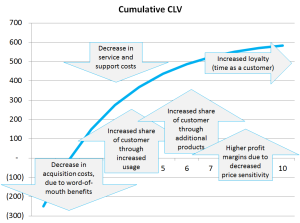Why calculate customer lifetime value?
Why has customer lifetime value – along with many other marketing metrics – becoming more important for marketers to use and understand? One of the key drivers is the shift from “art” to “science” in the marketing profession.
For many years, marketing was essentially a creative process or a people relationship skill – with the majority of marketers working either to deliver promotional campaigns or undertaking personal selling activities.
However, along with the Internet era, has been an increasing requirement for marketers to be more analytical and financially savvy in the development of marketing strategies and tactics. Marketing metrics, which enables marketers to analyze and determine the success of their marketing programs, are increasingly expected in the business community.
Shift from art to science in the marketing profession
Therefore, there has been a significant shift from marketing essentially being an “art” form to now becoming far more scientific and analytical. There are several reasons for this increase in the importance of evaluating marketing performance, these include:
- Significantly more customer and marketing data is now captured through new technologies,
- Marketers have software programs that make marketing data analysis much easier than in the past,
- Marketing environments are changing faster than in previous eras, with emerging new competitors being more of a threat than in the past,
- Many marketers realize that demonstrating financial expertise is a key requirement to being accepted at the executive and CEO level,
- The easy availability of website analytics (such as, Google analytics) is exposing more marketers to marketing metrics, and
- Many companies now view marketing as an investment (ROI) to be justified.
Customer Lifetime Value Benefits
Regardless of its potential challenges, customer lifetime value (CLV) is a powerful tool and a very important marketing metric – sometimes referred to as “the golden metric”. In particular it helps the marketer to:
- Measure and demonstrate the bottom-line financial impact of marketing activities,
- Clearly align marketing programs with financial objectives and targets,
- Focus on marketing from an marketing ROI perspective by determining the optimal balance between acquisition, share-of-customer, and enhanced loyalty objectives,

- Scenario test a range of possible strategic marketing directions,
- Determine the impact of internal marketing programs, as well as competitive and environmental factors on long-term customer profitability,
- The stress testing of various marketing goals and environmental impacts,
- Balance the competing needs of short-term profitability and longer term goals,
- Understand the bottom-line profit contribution of different customer segments,
- Demonstrate a long-term financial return for a range of marketing investments and
- As demonstrated in the diagram, the effective management of the customer relationship will result in enhanced profitability over time.
Related Topics
Drivers of the shift from art to science in the marketing profession
